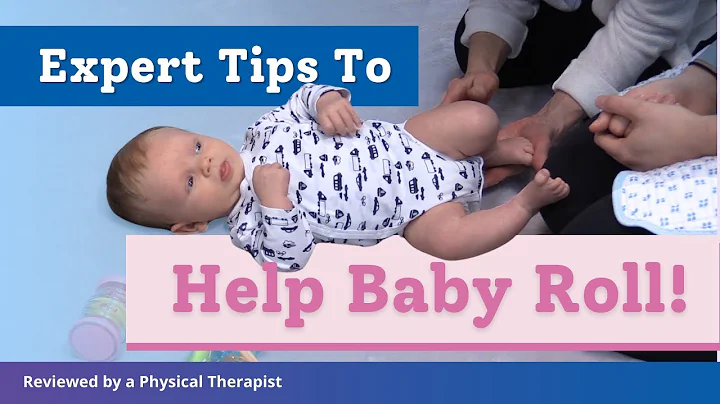As the old saying goes, " turns three times, sits six times, and crawls ." Usually when the baby reaches three months, adults will look forward to the baby turning over soon. If the baby shows no sign of turning over at this time, some elderly people will I started to mutter: Why can’t my child turn over? Is there something wrong?

American Academy of Pediatrics 2022 Developmental Milestones
I don’t know how the old saying spreads that people turn over in three months. In fact, most children learn to turn over in 4-5 months. . For example, American Academy of Pediatrics 2022 version of developmental milestones (the editor has written for reference before) believes that rolling from prone to supine is a requirement for children at six months , which means that it is normal for children to roll over on one side before six months.

Denver Child Development Screening Test Form
According to the Denver Child Development Screening Test Form (most domestic child care providers use this set for assessment), as long as the child learns to turn over on one side at -5 months, it is normal .
Based on these two sets of evaluation standards, most children will master the skill of turning over at five months old. If the child is more than six months old and still cannot turn over, it is necessary to consult a child development specialist in time. Of course, it does not mean that there is a problem if the child cannot roll over for six months. For example, some parents will wear very thick clothes for the baby in winter, which will also affect some of the baby's gross motor development . But now is the summer, which is the best time to exercise your baby's motor skills [呲呲].

How to guide your baby to turn over
Turning over is based on the development of neck, back, and waist muscles and the control of muscles. Before the muscles are exercised, there is no way to turn over immediately without any posture. "Lying down to sleep and playing on your stomach" is now highly advocated, because "lying down" is the best way to exercise your baby's neck, back and waist muscles! The editor's daughter learned to roll over at 110 days old. Now I will introduce to you the three obvious stages of muscle development before learning to roll over. With more guidance in these three stages, it is very easy for the baby to master the skill of turning over [呲呲].
1. Lie down more often to exercise the baby's head up → neck and back muscle development
- When the baby first starts to turn over, it must use its broad brain (large proportion of weight) to drive the body, so holding the head upright is the first step to turn over.

Lying down is the basis of all major movements.
- From the time the baby is born, you can let the baby lie on his tummy and practice raising his head. When the baby can steadily raise his head at 90°, he is not far away from turning over. Lying down is the basis of all major movements. Don't rely on sound and light toys when lying down. Interacting more with your baby can make them work hard to lift their heads. Holding the baby upright is similar to lying on the stomach for muscle training. If the baby likes to be held upright, adults can also hold the baby upright for a walk. It is also a good exercise for the neck and back muscles.
2. Break down the turning action → Back and waist muscle development
If you carefully break down the baby turning over, you will find that the baby who has just learned to turn over does not turn over like an adult by twisting the waist and kicking the legs. When a baby first turns over, he must use the power of his head and legs to drive the body to twist. The cerebellum, which accounts for 1/3 of the weight of the body, plays a really big role. This is why the editor said that the baby must be trained to raise his head first. Once the head is raised steadily, turning over will be a breeze.
When the baby can hold his head steadily at 90° and can flexibly control the head twist, it is recommended to use these two methods to help the baby turn over and exercise the baby's waist and back muscles.
- When the baby turns his head backward, you can gently give the baby a force, allowing the baby to experience the feeling of controlling the muscles to twist and turn over.

Give the baby a gentle push, put the baby in a semi-lying position, tease the baby with toys, and let him complete the rest of the turning movements on his own.When you first start practicing turning over, you can do both forward and reverse turns, because the same muscle parts are exercised. When my daughter first learned to roll over, she could only lie on her back and then on her stomach. There are also some babies around me who first learned to lie on their stomachs and then on their backs. Each baby's preferences are different. Place the baby in a semi-lying position, allowing the baby to complete the final turning movement. 
These two movements can stimulate the baby's waist and back muscles to exercise when the baby uses his head to drive the body and twist. Of course, the concentration and frequency are within the range that the baby can adapt well to. exercise.
.
3. Place your hands and feet to turn over on your own → Learn to control the muscles
Many people on the Internet teach you how to train your baby to turn over. This step is taught. Give the baby a little move with his hands and feet, and the baby will learn to turn over immediately. In fact, everyone knows how this is possible [covering face]. If you hold your head up unsteadily and your back muscles are not fully exercised, how is it possible that you can turn over just by waving your hands and feet?
At this stage, the baby's head, neck, and back muscles have been well exercised. The baby also has the awareness to turn over. He will often try to twist his head and use his body to turn over. It can be said that baby is only missing the "final kick". "The understanding, that is, the ability to control the body , may be twisted and twisted and suddenly one day you can master it. Therefore, we can help the baby place its hands and feet more, so that the baby can use more force to turn over, and exercise more to achieve "quantitative change to qualitative change".

Source: youtube
I believe you have also seen many ways to teach the baby to turn over by arranging the hands and feet. I recommend that you put one leg of the baby on the other leg when placing the hands and feet. It is enough to give the baby's butt a twisting force . For the rest, let the baby move on his own and feel the muscles exerting force when twisting the body.

What should you pay attention to after your baby learns to turn over?
- Beware of falling out of bed! Most babies fall off the bed for the first time at this stage. It happens at the stage of ", you thought he couldn't turn over yet, but he actually knows ". So be careful to always keep your baby in a safe place.
- More night awakenings. Babies who have just learned to roll over will want to roll over day or night. They may even suddenly roll over in the middle of the night and wake themselves up, collapse and cry. Sleep regression is more likely to occur at this stage and requires more comfort from adults.
- Don’t sleep on your stomach! Do not let the baby sleep on his stomach until he has just learned to turn over on one side. If he suddenly turns over on his stomach in the middle of the night, turn the baby to a flat position! At this age, it is easy to cover your mouth and nose when sleeping on your stomach. At the same time, the baby has not mastered the skill of turning back, so the risk is higher!

The above are some tips and points that need to be paid attention to in guiding the baby to turn over summarized by kk. I hope it will be helpful to everyone.
KK is a 985 engineering master and a mother who practices evidence-based parenting. Her daughter Damei was born in April 2020.
KK's evidence-based parenting system is based on the authoritative medical books "Nelson Pediatrics" and "Western Internal Medicine", etc., with reference to the latest domestic and foreign medical guidelines and papers, and combined with the parenting experience of oneself and those around him.
KK believes that the essence of parenting is full of love, and hopes to help more parents grow with their own knowledge.
♡If you like KK’s popular science, please follow me.





















